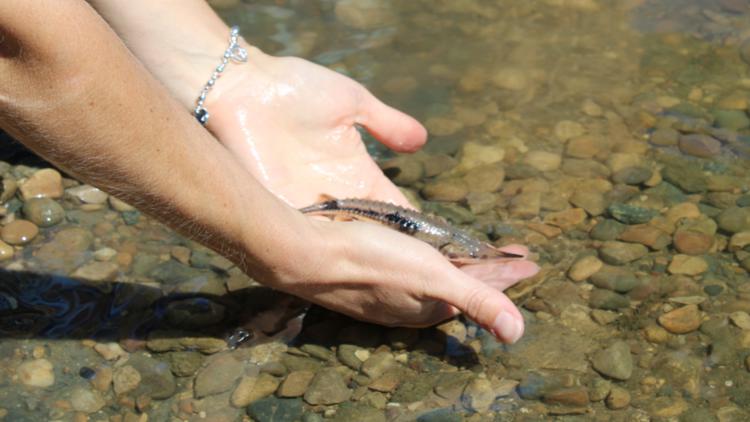SHELBYVILLE, Michigan — Hundreds gathered for the release of roughly 160 hatchery-raised lake sturgeon into the Kalamazoo River at New Richmond Bridge County Park on Friday.
The lake sturgeons, called nmé by Native Americans, were released by the Match-e-be-Nash-She-Wish Band of the Pottawatomi Indians, also known as the Gun Lake Tribe.
The release is an annual event for the Tribe, who let many of the children in attendance participate by releasing the fish into the river by hand.
Sturgeons were once highly populated in the Great Lakes, but are now a threatened and protected species.
"The Tribal approach to sustainable management is to recognize the impact that our current actions have on the next seven generations,” said the Tribe’s Environmental Director Liz Binoniemi-Smith. “The long life of the sturgeon requires careful management with this forward-looking approach and through careful conservation, we hope to support this animal that is so important culturally to Neshnabék (Anishinabe People) as well as to the Great Lakes ecosystem."
The fish eggs were collected in April 2024 from mats put in the Kalamazoo River by the Tribe's Environmental Department.
Once the eggs were hatched, the fish were raised in a stream-side facility until they grew to be six to eight inches long.
The hatchery used for the fish is a mobile-rearing facility.
Kalamazoo River water was used in the fish holding tanks to help them imprint with the river's "environmental code." This process will help the fish return to this portion of the river to spawn later in life.
Sturgeons grow slowly and don't start reproducing until they're around 20 years old.
Once fully grown, a sturgeon can weigh up to two hundred pounds and be more than six feet long.
On average, lake sturgeons can live anywhere from 50 to 80 years, depending on the gender. There have even been some female sturgeons recorded as living for up to 150 years.
The newly released sturgeons might stay in the Kalamazoo Lake or the Kalamazoo River, spending most of the fall and winter there before they migrate to Lake Michigan.
Alongside the hatchlings, five larger sturgeons from 2023's release that had been living in a tank at the Gun Lake Tribal Government Office will be released.
The larger fish have trackers in them so environmentalists can monitor their movements.
The Tribe maintains a reciprocal relationship with the nmé, along with the natural world.
“The Tribe respects nmé as kin, and nmé are a clan animal that are highly regarded for their wisdom from living on the earth for so long,” said Tribal Council Member and Elder Jeff Martin.
The event included educational booths, hatchery tours and a cultural presentation by the Tribe.
The Gun Lake Tribe partnered with the Michigan Department of Natural Resources, the U.S. Fish and Wildlife Service and Grand Valley State University on the release.



